How to make a septic tank from Eurocubes with your own hands: step-by-step assembly instructions
With an independent sewerage system, life in the country or in your own home will not be frightening due to the lack of basic amenities.If you don’t have extra funds to purchase a ready-made sewer point, you can build a septic tank from Eurocubes with your own hands. It will not require special investments. Agree, this is a solid plus.
We are ready to share truly valuable information with site visitors. We describe step by step the process of organizing a sewer system with wastewater treatment in a homemade structure. All the subtleties of the technological process are outlined, guaranteeing trouble-free operation of the system and its long, impeccable service.
The information presented to your attention is based on the personal experience of independent builders of their own sewerage structures from European packaging. The requirements of regulatory documentation are taken into account. To make the information easier to understand, step-by-step photos and useful video tutorials are included.
The content of the article:
Features of arranging a homemade septic tank
Arrangement of a sewer system using Eurocubes among summer residents is considered one of the most economical options.
Moreover, a properly manufactured and high-quality installed septic tank is able to effectively cope with the functions assigned to it.
Before deciding on this option, you need to learn about some of its features. Firstly, a home-made structure and its further installation will require enormous labor costs. You may have to resort to the help of 1-2 friends, acquaintances, or hired workers.
This is due to the large volume of excavation work - you will have to dig a lot. Also, in order to lower the already prepared container into the dug pit, you will need outside help.Despite the light weight of the structure, do not forget about the dimensions. It will be difficult to cope with such a giant alone.

Secondly, this option for solving the issue of local sewerage will only be successful if it is installed correctly. Otherwise, the septic tank may collapse in a couple of months or a year under the influence of environmental factors. All efforts and funds spent on the project will be in vain.
Thirdly, it should be taken into account that additional cleaning will definitely be required - after all, a septic tank made from Eurocubes is capable of purifying wastewater by 50-60%. The water coming out of it must necessarily pass through some kind of filter.
You should think about this at the design stage in order to calculate everything correctly. For example, to arrange filtration fields you will need a decent area.
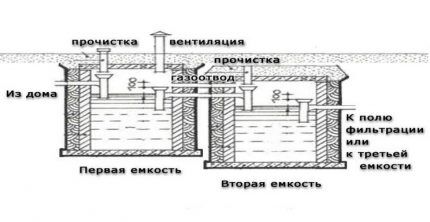
Assembly and installation technology
Often homeowners, wanting to save as much as possible on sewerage installations, think about how they can make a homemade septic tank from Eurocubes.
This option looks very attractive financially, which allows it to look advantageous against the backdrop of expensive factory installations. Moreover, if you do everything yourself, without ordering a turnkey project, the savings will be significant.
Step #1 - design and calculations
The decision to equip a local sewage system using so-called “flasks” or Eurocubes occurs quite often.Some summer residents speak enthusiastically about this option, calling it successful, profitable and effective.
Others, on the contrary, say that having once spared money for high-quality factory equipment, they had to pay twice - such a septic tank was crushed by soil in a matter of days.
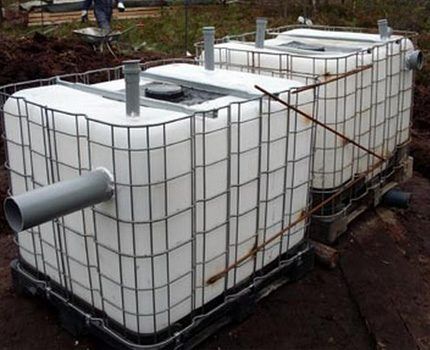
Both supporters and opponents are right in this dispute. In fact, these containers can successfully serve as a septic tank only if they are installed correctly. It is important to consider the type of soil in a particular area. If you ignore this point, the container will simply compress and you will have to start all over again.
Before you start assembling a septic tank with your own hands, you need to calculate the water consumption consumed per day for household needs and discharged into the sewer. This is convenient to do if a counter is installed. Otherwise, you will have to calculate the value yourself.
It is not advisable to take the recommended rate of 200 liters per person per day, because often a family of 5 people uses only 400-500 liters. The real value will have to be multiplied by 3. This is exactly the volume of the septic tank - it should contain wastewater for 3 days.
Having decided on the volume of the container, you have to choose the optimal place to place it. Here it is worth considering that the pipes to and from the septic tank go in a straight line, without bends. Otherwise, blockages will often occur that will have to be eliminated.
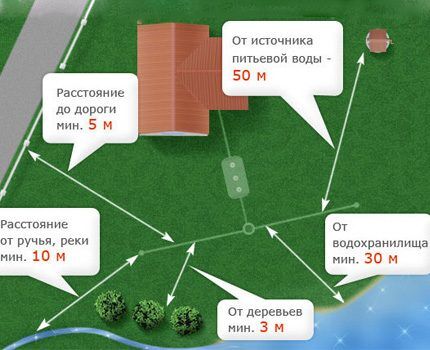
First, you have to dig a trench to lay the supply pipeline, through which the sewage will flow into the first container - the receiving tank. Then you need to dig a pit for the septic tank, taking into account its dimensions and adding an additional 15-20 cm on the sides for proper installation.
The depth of laying pipes connected to the treatment plant must be below the freezing level, but not deeper than 3 meters from the surface.
Next, you need to dig a trench for the outgoing pipeline and choose the option of additional treatment of the wastewater leaving the septic tank. After all, they will be purified by 50-60%, which is extremely low for safe disposal into the nearest body of water or onto the terrain.
The liquids must undergo further purification:
- in the filter well;
- on filtration fields;
- on filter mounds (embankments).
It is one of these options that is most often used. Therefore, it is important to immediately provide space for the installation of an additional filtration zone.
The next stage is the transformation of the Eurocube into a septic tank. For these purposes, it will have to be slightly modified using pipes, tees and consumables. The container itself is sealed, the wall thickness is from 1.5 to 2 mm. It is made of polyethylene, which can withstand caustic substances and acids without reacting with them or being destroyed.
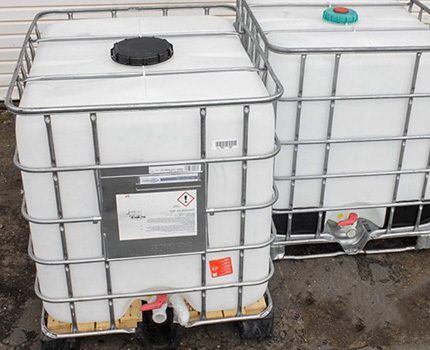
When converting the flask into a septic tank, the drainage area must be hermetically sealed to avoid wastewater leaking into the ground. The same should be done with the second and third cube, if the future septic tank will consist of more than one chamber.Most often, home craftsmen use 2 or 3 eurocubes. Options with 1 or more than 3 are rare.
For a septic tank, you buy containers intended for non-food products. Moreover, you can save significantly by choosing an unwashed used flask. It is easy to wash it with water, and complex contaminants will not in any way affect the effectiveness of the future septic tank.
The standards for connecting the sewer pipe should be taken into account. This is 20 cm below the top edge of the container. Next, you need to place 2 tees inside the container, cutting a hole of sufficient size for this. Subsequently, the holes must be carefully welded and covered with a layer of waterproofing.

The inlet pipe and the pipe going up are horizontally connected to the first tee. It will be used for cleaning and inspection. A pipe will be attached to the second tee to connect the 1st container with the second and a pipe of smaller diameter for ventilation.

Moreover, the outlet from the first flask, through which it will be connected to the 2nd, should be lower than the inlet. All joints and openings are carefully sealed to avoid leaks.
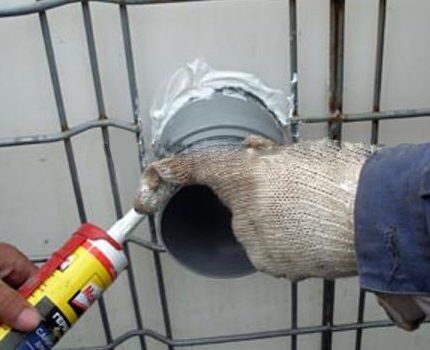
As for the second container and subsequent ones, if they are provided for in the project, then each of them should be located 20 cm lower than the previous one. Based on this, all the holes have to be cut.
Their number is the same as for the first flask.Only the outlet in the last Eurocube will be connected to the pipe leading the treated wastewater to the filtration fields. It is advisable to provide him check valve.
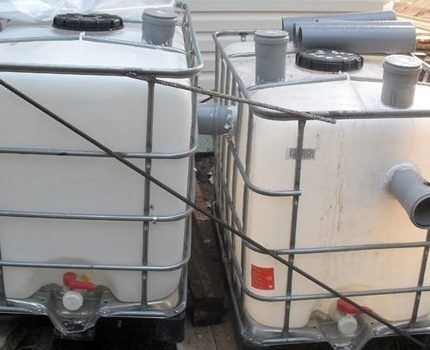
Step #2 - installation and installation
When all work on installing pipes and sealing joints is completed, you can proceed to the next stage - installation.
The type of soil matters here - with clayey, mobile soils, it is important to compact the bottom as efficiently as possible by constructing a cushion of sand and gravel. A concrete screed should be made on top of it to ensure that the bottom does not deform under the weight of the filled flasks.

Then you have to lower the septic tank into the pit. It is advisable to anchor it to further secure it in place and protect it from floating. Now you need to connect the incoming and outgoing pipelines to the septic equipment.
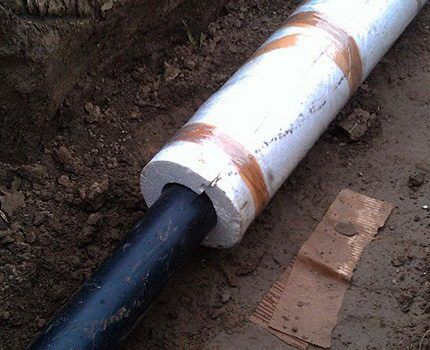
The walls of the septic tank and the pipeline will need to be insulated. To do this, you can take polystyrene foam or other material. All that remains is to fill the cleaning equipment, assembled with your own hands, with water and cover everything with sand.
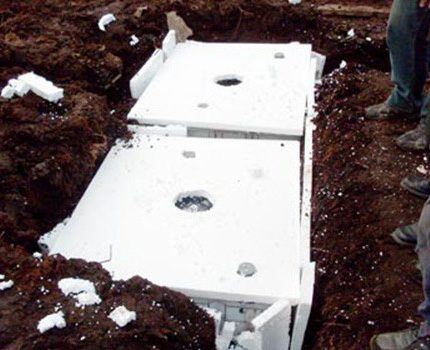
If the groundwater level is high, the walls of the Eurocubes will have to be further protected by pouring concrete. To do this, reinforcement or boards are placed in the gap between the container and the pit wall and the concrete is carefully distributed. If you do everything consistently, not forgetting to fill the septic tank with water, then the walls will not deform.
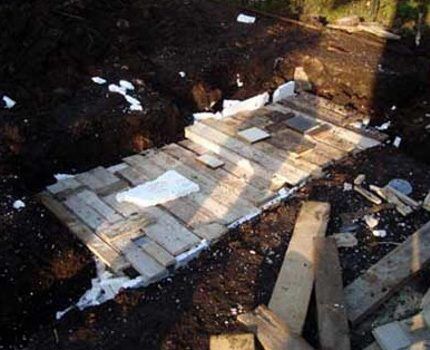
Whether or not to concrete the top of the pit depends on the terrain. Pipes protruding above the surface must be protected so that nothing unnecessary gets into the septic tank through them.
To perform ground-based post-treatment of wastewater treated in a septic tank, it is necessary to construct one of the following structures:
Step #3 - further maintenance
In a private household, every screw requires periodic attention from the owner. Local sewerage is also no exception.
A do-it-yourself septic tank will last a long time only subject to periodic inspections and maintenance. For this purpose, special large-diameter pipes were installed at the installation stage.
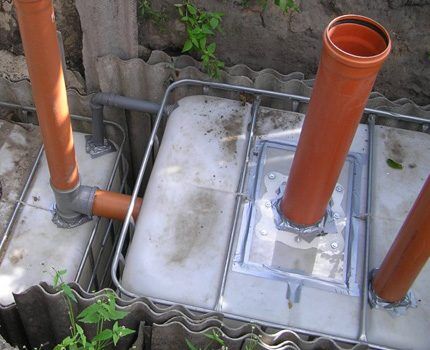
On the surface of the drains in the first chamber of 2, 3 or more chamber septic tanks, fatty substances, pieces of polyethylene and other light substances that have entered the sewer float up.
Periodically, the layer that cannot be decomposed must be removed mechanically. The frequency of such manipulations depends on the intensity of use of the septic tank and careful treatment of it.
You should also check the amount of solid deposits at the bottom of each container in the fall. If their accumulation is large enough, you will have to call a sewer truck or pump it out yourself with a fecal pump. Such sludge can be dumped into a compost pit for further use as organic fertilizer.
Every spring you need to check how the septic tank survived the winter. Especially if no one lived at the dacha during this period. If damage to the container is detected, work must be carried out immediately to repair or replace it.
You should not allow the sewer system to start running with a faulty septic tank - the wastewater can get into groundwater, which will harm the environment.
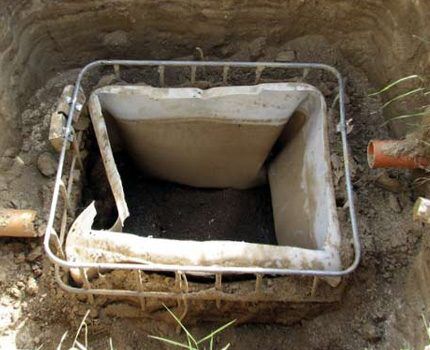
To speed up the decomposition of organic waste, you can add special bacteria for septic tanks. But if the container is regularly filled with waste water, there is no particular need for this. Microorganisms that feed on organic matter multiply massively and process everything that comes in without outside intervention.
Pros and cons of a septic tank made from Eurocubes
A homemade septic tank made from one or more Eurocubes has a number of positive and negative aspects. It can become a convenient and economical option for private households, solving the issue of arrangement autonomous sewage system for a bathhouse or all objects on the site.
Disadvantages of the cleaning system
It is worth noting that self-assembly and installation of cleaning equipment from Eurocubes will take more than one day. But, if all the work is carried out correctly and in full, the result will please every zealous owner.
The following are the most significant disadvantages of this treatment plant:
- a large front of heavy work;
- strict installation rules;
- need for periodic maintenance;
- short service life.
If excavation work is not scary and there is no desire to invite help, then digging a pit and trenches can be done alone in a week or two. Everything will depend on the length of the home handyman’s working day - the work is not difficult, but physically difficult.
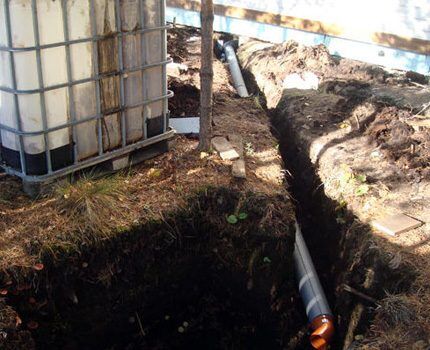
As for the strict rules, failure to comply with them will lead to the fact that the septic tank will collapse and all work will have to be carried out anew, except for digging trenches for pipelines. Moreover, you can read many reviews on the Internet about this scenario.
In an effort to quickly install a sewer system on private property and sacrificing the quality of work, the owners received an extremely unsatisfactory result.
If you want to do everything quickly with minimal investment of effort and time, then it’s easier to buy ready-made biological treatment equipment with installation by specialists. This will turn out to be cheaper than spending two or three times on building a septic tank from scrap materials.
A homemade structure, like many other types of sewerage installations, will require periodic maintenance. Indeed, in the container itself, insoluble substances in the form of fat, accidentally washed away plastic bags and other items will accumulate in the top layer.
Such waste will have to be caught from the surface, and solid silt deposits will need to be removed from the bottom.
A treatment facility constructed from Eurocubes is capable of processing wastewater for at least 10 years. Moreover, its service life will directly depend on the type of material used when installing the containers.

If a frame was made around it from boards that were not pre-impregnated with a special protective compound, then such a structure will rot very quickly.In the future, everything will have to be excavated and additional work carried out - after all, a Eurocube simply buried on the site cannot serve as a septic tank.
To prevent it from being crushed, you need to perform a number of measures depending on the type of soil and its mobility.
Advantages of a homemade septic tank
Homemade equipment made from Eurocubes can become a reliable part of the sewer system in a country house/cottage.
It has a number of positive qualities:
- simple and inexpensive components;
- ease of container preparation;
- reliable wastewater treatment;
- the ability to install additional sections;
- assembly of the system does not require special knowledge and skills;
- complete energy independence.
The system does not require electricity to operate, which is the most significant advantage for many summer residents. Sometimes this factor is decisive when choosing the type of local sewerage system.
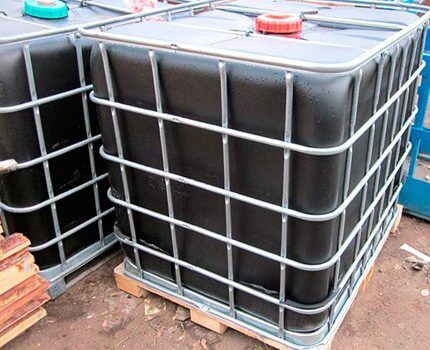
The price of containers is relatively low, especially if they are used, plastic pipes, cuffs, tees, other components and consumables allow you to build an inexpensive septic tank. This attracts hardworking home owners with skillful hands.
An undoubted advantage is the ability to add one or two additional sections at any time, i.e. increase the total volume. To do this, even at the design stage, it is necessary to install a spare pipe by sealing the hole.You should also choose the installation location so that additional sections, if necessary, will fit on the site.
If these conditions are met, then when you are planning to connect an additional container, all that remains is to dig a pit for it and prepare it accordingly. Next, all that remains is to connect the new Eurocube with the already installed one into a single system, using previously supplied and preserved pipe outlets.
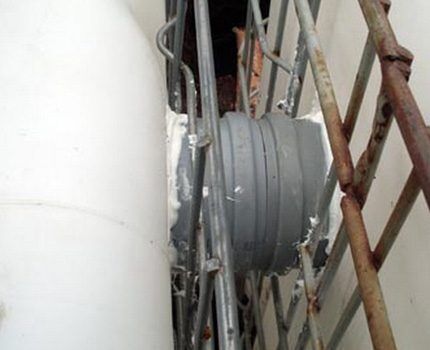
A plastic container made of dense material can last a long time. But due to the absence of stiffeners and the presence of an external metal grid that protects it from compression, various scenarios for the development of events are possible. Such a septic tank will be afraid of corrosion - if the frame collapses, the plastic container will quickly crumble.
Instead of Eurocubes, you can use a ready-made septic tank in a homemade septic tank. plastic container, however, its purchase will increase the costs allocated for the construction of the system.
Therefore, it is possible to talk about a service life exceeding 10 years, but with a reservation regarding the materials used during installation. The more durable and reliable they are, the longer the homemade septic tank will work.
The polyethylene container itself can last for decades if substances that can destroy plastic - chlorine, fluorine, 50% nitric acid solution - are not poured down the drain.
We invite home craftsmen to familiarize themselves with another budget option septic tank structures, which is actively used in the arrangement of summer cottages.
Conclusions and useful video on the topic
Video material about the excavation work performed for the installation of a septic tank from Eurocubes:
Step-by-step video about installing a septic tank from 2 eurocubes with your own hands. The second part of the video confirms the fact that with high-quality installation nothing gets wrinkled:
Detailed video about preparing a Eurocube for a septic tank:
Video about the types of containers that can be used to make a septic tank:
Having studied the issue of independently manufacturing and installing a septic tank from Eurocubes, it is easier to decide whether this option is suitable for a summer house or a home with permanent residence. This type of treatment facility for local sewerage is easy to implement, but will require a lot of effort to complete the installation efficiently and correctly.
We are waiting for your stories about how you yourself built a septic tank on a suburban plot, using waste structures such as Eurocubes. Please write in the block intended for posting comments. Ask questions here.




I made the same septic tank at the dacha. While we were installing amenities in the house, a sewage problem arose. At first I thought about doing something similar with a cesspool, but then I decided that this was the simplest, safest and most inexpensive option. I bought used Eurocubes. The hardest part was digging the hole itself. It was very expensive to call the equipment. But I managed it in three days. Everything is great now. The best option in terms of price/quality ratio.
I want to build a septic tank from Eurocubes for a country house, but I’m afraid that such a solution is not very suitable for my region. We have harsh winters, temperatures often drop below -35 degrees. I'm afraid that this will make the plastic brittle and eventually crack.Do you think that by digging such a septic tank deep enough and additionally insulating it, you can solve this problem or is it better to buy a regular iron tank?
You just need to bury the septic tank below the freezing depth.
Hello. It was correctly written above that you need to dig the Eurocube below the freezing depth of the soil. But there is one nuance here - the very depth to which you need to dig! If the depth is too great, then it may not withstand the pressure from the weight of the soil that will be located above it. Therefore, if the soil freezes to a depth of more than a meter, it will be important not to dig so deep, but to insulate it.
To insulate a septic tank in this case, you can use different materials, the same polystyrene foam, for example. It should be remembered that it is necessary to insulate not only the septic tank, but also the pipes. For the latter, ready-made foam solutions are also sold.
A lot of unnecessary text and complications! After such an article, I certainly won’t want to build a septic tank according to your advice! More positive, author!